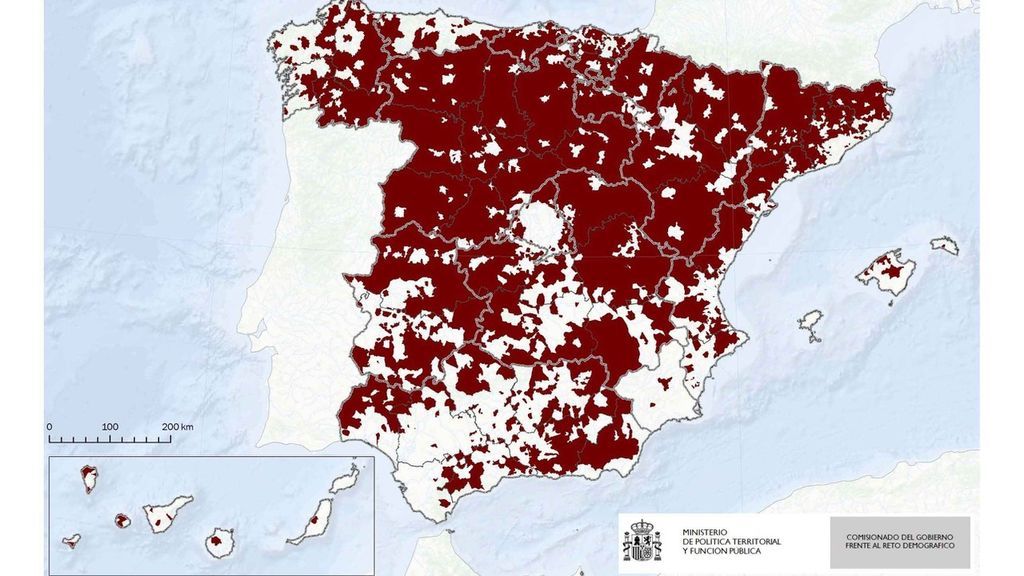
Day by day, we are increasing the list of sections of 'Uppersgram', our space for interviews and live chats on our Instagram account. Today we have started with 'La edad por el tejado', the section of Paz Martín (49), an architect and longevity expert. Paz Martín has been fighting for years for the conversion of cities into sustainable, accessible, adapted and age-friendly spaces.
Today we have inaugurated her format in which every Friday, live, she will talk to us about architecture, ageing, the possibilities of the rural environment or different business and development opportunities. In today's talk, 'Menos mal que nos queda lo rural', he explained the demographic map of our country and the problem of the abandoned territories, the emptied Spain. In addition, he has also presented us with interesting alternatives aimed at repopulating rural areas and reducing the exodus to the cities. "We have to consider that we could be the California of Europe if we managed to make our ageing process avant-garde", he said. "In Spain there are six million people over the age of 65 who visit us on a temporary basis every year. English, Germans... who have second homes here because they decided they were going to grow old here. If we offer them alternatives (leisure, historical, tourist, gastronomic...) we could have a business model with them in mind".
Thank goodness we still have the countryside
Spain has a large majority of rural areas: 94%, which represents more than 400,000 square kilometres. Moreover, 60% of rural municipalities have a highly ageing population (two people over 65 for every one under 15) and many of them are already inhabited only by people over 65.
According to the INE, 90% of the population of our country lives in 30% of the territory, and the remaining 10% in 70% of it. This clear demographic imbalance, together with the rural exodus, has set off alarm bells. For years now, many sectors have been calling for a national strategy to alleviate these problems.

Municipalities that concentrate only 10% of the Spanish populationMINISTRY OF TERRITORIAL POLICY AND THE PUBLIC SERVICE
Why should we think that this picture could change?
On 20 February 2020, the Guggenheim Museum in New York opened the exhibition 'Countryside: The Future' by the influential Dutch architect and intellectual Rem Koolhaas, known for his provocative spirit, for whom I had the good fortune to work in the past.
The exhibition, which has nothing to do with architecture or art, aims to rectify the massive lack of interest in the rural that has occurred in recent years, overshadowed mainly by a focus on cities. In Rem's words: "We wanted to put the rural back on the agenda, and also to show that the countryside is a territory or domain, where you can have a full life.
What is most interesting about this is that Rem is, precisely, renowned for his tireless interest in the evolution of contemporary metropolises. And this should make us think how interesting it is that it is precisely he who reminds us that the future of architecture lies in understanding the challenges posed by the rural environment, overshadowed until now by the cities, and in which radical changes are already taking place.
And in Spain?
El Hueco' was born as a programme of the NGO Cives Mundi 9 years ago. It is an ecosystem for the promotion of social entrepreneurship, the start-up and development of business initiatives related to technology, environment, art, architecture, communication, social action, etc. that contribute to the repopulation of rural Spain.
Their areas of work are not only limited to the generation of a new business fabric or innovation in rural areas, one of their goals is also to escape from victimhood and change the narrative, so that potential repopulators can understand that the rural world is yet to be discovered and that it is really the place where there are infinite opportunities, not only to work in the countryside but also to be able to work from it.
In November 2017 they decided to launch PRESURA in Soria, the first fair for the repopulation of empty Spain, which is now in its fourth edition with undeniable data. In three days of fair you can visit exhibitors of entrepreneurial experiences in rural environments, but you can also attend debates, presentations, competitions, concerts and, of course, networking. This year, covid has transformed the event into something much more interactive and less face-to-face.
Why am I interested in the rural world as an expert in longevity and architecture?
It is a fact that the rural lifestyle, with its faults and virtues (continuous activity, absence of pollution, close human and social relations, feeling of rootedness, healthy food, etc.), has a very positive impact on the life expectancy of its inhabitants, with very old people living in rural areas being very common.
But also the exodus of young people from these localities, in search of new opportunities, has meant a rural panorama of a highly ageing population, with the consequent lack of services. This inevitably results in many older people having to move to larger towns or even cities in order to continue their lives.
In my opinion, the serious problem lies in the fact that up to now solutions to this situation have been approached from an eminently urban or city perspective. In other words, from the point of view of efficiency and clear economic optimisation. The real needs of these places have not been taken into account. The good news is that it is precisely in rural environments that the dimension and scale of this problem allows for more innovative social solutions.
It is also true that many older people living in big cities have started an exodus to rural areas where they can grow old in a healthy and active way. And not only them: the phenomenon of teleworking, favoured by covid, has unleashed in many people a hitherto unknown interest in returning to rural environments.
In this sense, and as a firm believer that the 'silver economy' is and will be a major economic driver, I can only see the rural world as a blank canvas yet to be filled with regard to social innovation.
That is why, since 2019, I am part of the G100 housing group: a group of 100 people from all over Spain participating in Terris (Territorios e Innovación Social) in the process of co-creating a new rurality.
Examples of rural uppers initiatives
The first of these is 'Vellosillo Dreams', an initiative of Jorge Juan, an upper ex-economist who has created a self-managed rural arcadia to repopulate Vellosillo, a village in Segovia. Vellosillo Dreams' is a venture capital fund that called for proposals for companies (innovation, technological, environmental...) to apply to set up their business in 'Vellosillo'. In less than three months they received 400 proposals. And now five cutting-edge, replicable, sustainable and innovative projects are underway. In one week, Vellosillo received 300 applications to live in the village.
There are also initiatives proposed by young people and aimed at uppers. One of them is the rural butlers, a social logistics initiative. It is a company that distributes services and products in rural environments and enables the elderly population to stay there. People who live in the village do not pay for this service, so they do not pay more for the product than someone in the capital would. They started with food, but today they distribute toys, gardening and a whole range of other products and services. It is also interesting because if there is a shop in the village, they do not serve products that you can find in that shop, so that the owner does not have to close down and leave.
Finally, another beautiful initiative is 'Brisa del Cantábrico', a senior cohousing project in Meruelo (Cantabria). Phenomena such as senior cohousing, 70% of which are located in rural environments, represent a new, socially sustainable way of living in old age and, as a result of their location, considerably increase the rural population figures, providing more public services, and also providing leisure and participation resources for the local elderly population.
On the other hand, they also represent a clear economic driving force for these localities, due to the need for associated services that these communities demand.